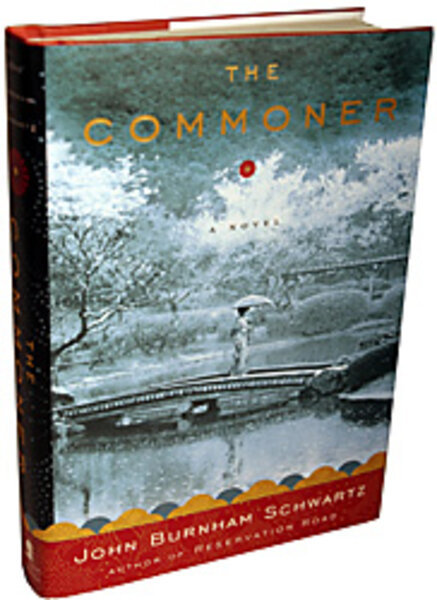No fairy tale for a mere commoner
In a page right out of "Cinderella," a prince meets a beautiful commoner, falls in love, and decides to carry her off to his palace.
Only, instead of medieval France, it's Japan in 1959. Instead of a glass slipper, Haruko Endo has a tennis racket, with which she thoroughly trounces said prince on the court. And unfortunately, central casting forgot to send a fairy godmother, which is a shame, because Haruko really, really could have used one.
Based on the lives of the current empress and crown princess of Japan, The Commoner, the fourth novel by John Burnham Schwartz ("Reservation Road") taps into the trend of blurring the lines between fact and fiction to pen a melancholy meditation from the viewpoint of the first commoner ever to marry into Japan's royal family.
Haruko grew up the beloved only child of a wealthy sake manufacturer, whose money enabled his family to escape the fire that destroyed much of Tokyo during World War II and cushioned them from the lean years that followed Japan's defeat.
Educated at the elite Sacred Heart school, Haruko grows into an intelligent, introspective teen who loves art history and athletics.
Then, at a doubles tournament, Haruko catches the eye of the prince. Over the next few months, Haruko regularly beats the prince at tennis, and the two share a handful of dates off the court – sitting in a storeroom while tea bags are unloaded; dancing at a ball.
When the prince sends an emissary to Haruko's parents, her loving dad is horrified and begs the emissary to leave his family alone. Unfortunately, true love conquers all, and Haruko is soon hermetically sealed inside the ritualized, highly rarified world of the imperial palace, where she is subject to the whims of her mother-in-law, the empress, and her poisonous assistants.
"Every day, without fail, I entered a room too quickly, spoke too often or too loudly, waved my hands in a coarse fashion, scratched an itch, offered an opinion, bowed to an angle of less than 60 degrees before my parents-in-law, and so forth," Haruko remembers of her first months as a princess. "I was, at first, under the illusion that my mistakes would be viewed as temporary surface flaws, nicks and scratches easily healed. But as the weeks passed ... I was gradually disabused of my naivete and made to understand that in a world constituted entirely of surface, all flaws run deep."
After giving birth to a son, Haruko suffers a nervous breakdown, unable to speak for months. Some 30 years later, when her son falls in love with another commoner – this time a Harvard-educated woman with a career in the foreign ministry, Haruko finds herself torn between her son's hopes and the desire to help a young woman whose background reminds her so much of herself.
Instead of overwhelming a reader with the amount of research he must have done, Schwartz instead selects evocative details to paint finely wrought miniatures of the past.
The privations of World War II are summed up by a trip to Haruko's bakery, famous for its kasutera (a snack cake). "When the ovens were going at full strength, the entire neighborhood smelled like warm sponge cake. Outside the shop, the line of customers would start forming early and keep growing until day's end."
After the war made even powdered eggs a rarity, the bakery was forced to switch to whale-ham sandwiches.
"And it is hardly an exaggeration to say that the sound of air-raid sirens ... caused but minor distress compared with the fishy, metallic taste of whale ham on the tongue. The smell of freshly baked kasutera, which had sustained us as a people was suddenly gone ... and from that moment forward the street gave off the faint putrid whiff of a marine graveyard."
There are times when a reader wishes Schwartz would have gone into more detail. It's implied that Haruko is able to give her daughter – who as an adult makes the reverse journey from her mother, going from princess to commoner – a stable childhood, but we only get a glimpse of it.
And Haruko's childhood friend Miko, a runner who laughingly calls herself "a squid on a stick," is limited to brief appearances.
While "The Commoner" is a compassionate portrayal, the life it portrays is a stifled, unhappy one. And since Schwartz hues closely to the few facts known about the Empress Michiko, who met her husband on a tennis court and is rumored to have lost her voice for months during the 1960s, readers may have an uncomfortable feeling of eavesdropping where they clearly aren't wanted.
The question of the ethics of artistic appropriation is a complicated one, and one that all writers (and readers) need to sort out for themselves. The trend of mixing history with fiction can make for fascinating, intellectually rich reading, and Schwartz's delicately rendered novel is nowhere near Kitty Kelley or Andrew Morton territory.
"The Commoner" is more in line with Mark Helprin's "Freddy and Fredericka," which offered a through-the-looking-glass version of the lives of Prince Charles and Princess Diana – although Schwartz is far gentler with his alterna-royals. And certainly, writers strip mine the lives of their less-illustrious friends and relatives all the time – the general reader is just blissfully unaware.
But when the life being appropriated is still being lived, one is reminded of Joan Didion's unequivocal statement in "Slouching Towards Bethlehem": "That is one last thing to remember: writers are always selling somebody out."
• Yvonne Zipp regularly reviews fiction for the Monitor.





